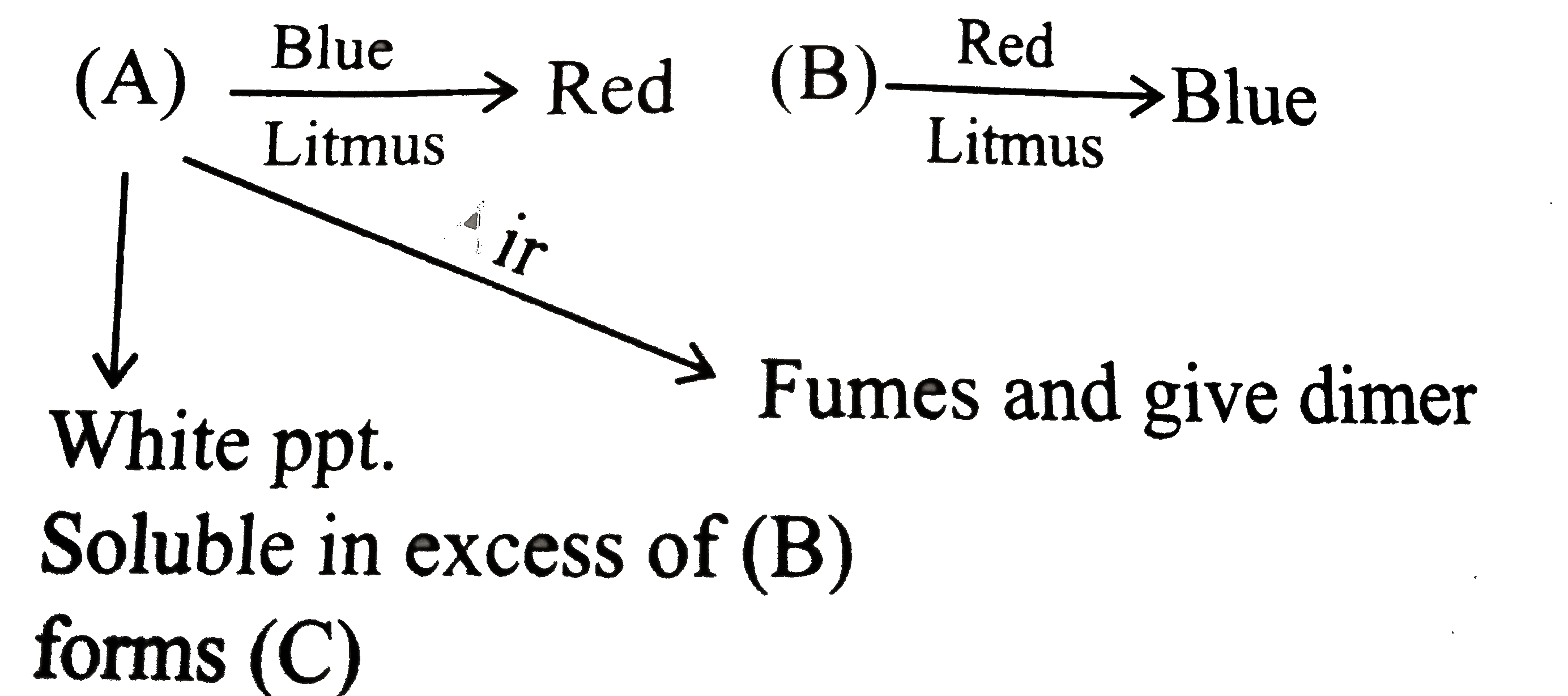A colourless mixture of two salts (A) and (B) (excess) is soluble in H2O.(A) turns blue litmus red and (B) turns red litmus blue. (A) gives white precipitate with (B), which dissolves in excess of (B) forming (C).(A) when placed in atmosphere gives fumes and can form dimer. (A) gives white precipitate with NH4Cl and NH4OH which is soluble in (B). Identify (A),(B) and (C). Explain reactions.
To solve the problem, we need to identify the two salts (A and B) and the compound (C) based on the given clues. Let's break down the information step by step.
Step 1: Identify Salt A
The problem states that salt A turns blue litmus red. This indicates that A is acidic in nature. A common salt that fits this description is Aluminum Chloride (AlCl3).
Step 2: Identify Salt B
Next, we know that salt B turns red litmus blue, indicating that it is basic or alkaline in nature. A common salt that fits this description is Sodium Hydroxide (NaOH).
Step 3: Reaction Between A and B
The problem states that A gives a white precipitate with B. When Aluminum Chloride (AlCl3) reacts with Sodium Hydroxide (NaOH), it forms Aluminum Hydroxide (Al(OH)3), which is a white precipitate:
AlCl3+3NaOH→Al(OH)3↓+3NaCl
Step 4: Formation of Compound C
The problem mentions that the white precipitate (Al(OH)3) dissolves in excess of B (NaOH) to form compound C. This compound is Sodium Aluminate (NaAl(OH)4):
Al(OH)3+NaOH→NaAl(OH)4
Step 5: Additional Properties of A
The problem states that A (AlCl3) gives fumes when placed in the atmosphere and can form a dimer. Aluminum Chloride can dimerize to form Al2Cl6, especially in the presence of moisture, which can lead to the release of HCl fumes.
Step 6: Precipitation with Ammonium Salts
The problem states that A gives a white precipitate with NH4Cl and NH4OH, which is soluble in B. The white precipitate formed is again Aluminum Hydroxide (Al(OH)3), which is soluble in excess NaOH.
Summary of Identifications
- Salt A: Aluminum Chloride (AlCl3)
- Salt B: Sodium Hydroxide (NaOH)
- Compound C: Sodium Aluminate (NaAl(OH)4)
Reactions Summary
1. Formation of Precipitate:
AlCl3+3NaOH→Al(OH)3↓+3NaCl
2. Dissolving Precipitate in Excess NaOH:
Al(OH)3+NaOH→NaAl(OH)4
The problem states that salt A turns blue litmus red. This indicates that A is acidic in nature. A common salt that fits this description is Aluminum Chloride (AlCl3).
Next, we know that salt B turns red litmus blue, indicating that it is basic or alkaline in nature. A common salt that fits this description is Sodium Hydroxide (NaOH).
The problem states that A gives a white precipitate with B. When Aluminum Chloride (AlCl3) reacts with Sodium Hydroxide (NaOH), it forms Aluminum Hydroxide (Al(OH)3), which is a white precipitate:
The problem mentions that the white precipitate (Al(OH)3) dissolves in excess of B (NaOH) to form compound C. This compound is Sodium Aluminate (NaAl(OH)4):
The problem states that A (AlCl3) gives fumes when placed in the atmosphere and can form a dimer. Aluminum Chloride can dimerize to form Al2Cl6, especially in the presence of moisture, which can lead to the release of HCl fumes.
The problem states that A gives a white precipitate with NH4Cl and NH4OH, which is soluble in B. The white precipitate formed is again Aluminum Hydroxide (Al(OH)3), which is soluble in excess NaOH.
- Salt A: Aluminum Chloride (AlCl3)
- Salt B: Sodium Hydroxide (NaOH)
- Compound C: Sodium Aluminate (NaAl(OH)4)
1. Formation of Precipitate:
AlCl3+3NaOH→Al(OH)3↓+3NaCl
Al(OH)3+NaOH→NaAl(OH)4
Topper's Solved these Questions
- BOOK - CENGAGE CHEMISTRY ENGLISHCHAPTER - P-BLOCK GROUP 13 - BORON FAMILYEXERCISE - Ex 6.1 (Subjective)17videos
P-BLOCK GROUP 13 - BORON FAMILY
- BOOK - CENGAGE CHEMISTRY ENGLISHCHAPTER - P-BLOCK GROUP 13 - BORON FAMILYEXERCISE - Ex 6.1 (Objective)14videos
P-BLOCK GROUP 13 - BORON FAMILY
- BOOK - CENGAGE CHEMISTRY ENGLISHCHAPTER - P-BLOCK GROUP 13 - BORON FAMILYEXERCISE - Exercise Archives (Subjecive)9videos
P-BLOCK GROUP 13 - BORON FAMILY
- BOOK - CENGAGE CHEMISTRY ENGLISHCHAPTER - ORGANIC REACTION MECHANISMEXERCISE - Analytical and Descriptive6videos
ORGANIC REACTION MECHANISM
- BOOK - CENGAGE CHEMISTRY ENGLISHCHAPTER - P-BLOCK GROUP 14 - CARBON FAMILYEXERCISE - Exercises Archives (Subjective)9videos
P-BLOCK GROUP 14 - CARBON FAMILY
Similar Questions
Knowledge Check
- Question 1 - Select One
The blue litmus is turned red by an aqueous solution of
AKNO3BNaClCCuSO4DCH3COONa. - Question 2 - Select One
An inorganic compound (X) shows the following reactions :
(a) It is white solid, exists as dimer and fumes in moist air.
(b) It sublimes at 180∘C and forms monomer on heating to 400∘C.
( c) Its aqueous solution turns blue litmus red and gives a white precipitate with AgNO3 solution which is soluble in excess of NH4OH.
(d) Addition of NaOH to the solution of (A) gives a white gelatinous precipitate which is, however, soluble on excess of NaOH.
Identify the compound (A).AAI(OH)3BAI2CI6CAI2O3DAI2(SO4)3
A colourless mixture of two salts (A) and (B) [excess] is soluble in H2O.

Identify AView SolutionName the gas that
turns moist red litmus blue.View SolutionAcidic oxides that are dissolved in water turn blue litmus red. Why?
View Solution(A) (colourless solution ) gives white ppt (B) with NaOH solution but ppt dissolves in excess of NaOH forming (C ). (C ) does not give ppt with H2S but on boiling with NH4CI, white ppt (B) appears. (A) also gives yellow ppt with AgNO3 identify (A),(B) and (C )
View SolutionIdentify the cation in each of the following case
Ammonium hydroxide solution when added to the solution B gives white precipitate which dissolves in excessView SolutionHgCl2 reacts with excess of KI to give a red precipitate A which becomes soluble in excess of KI to form compound B. A and B are respectively
View Solution


